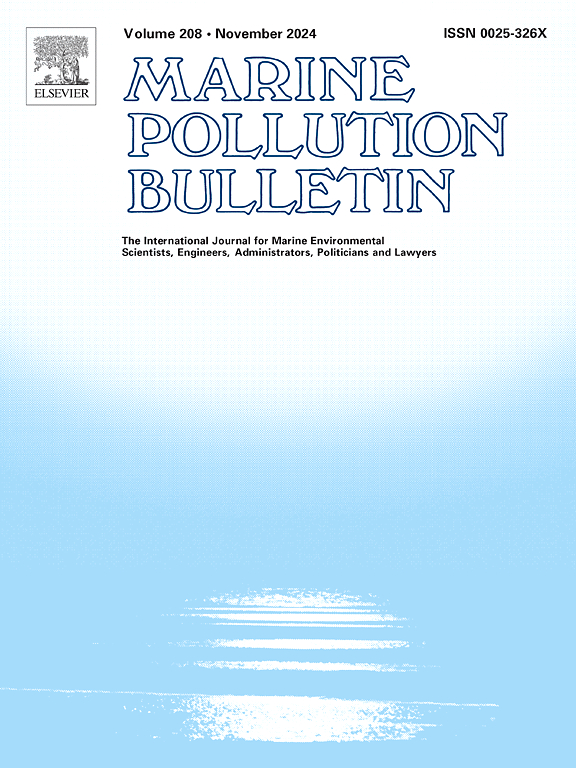黑海浮游植物的功能类型。一种结合原位高效液相色谱色素分析和卫星观测的区域化生态系统监测算法
IF 4.9
3区 环境科学与生态学
Q1 ENVIRONMENTAL SCIENCES
引用次数: 0
摘要
黑海浮游植物在区域生物地球化学循环中发挥着关键作用,但其复杂的光学环境给遥感监测带来了重大挑战。本研究开发了一种专门为黑海量身定制的浮游植物功能类型(PFTs)和大小类别(psc)的区域化算法。利用2006-2019年12次生物光学活动中收集的690个站点的高效液相色谱(HPLC)色素数据,我们应用层次聚类、主成分分析和基于网络的群落检测来识别优势浮游植物类群,并表征其时空变化特征。我们从色素特征中导出了用于估计PFT丰度的区域特定系数,并开发了将叶绿素-a与PFT分布联系起来的算法。将这些算法应用于1998年至2024年的卫星衍生叶绿素-a数据集,我们生成了长期气候学,揭示了明确的空间格局:营养丰富的西北陆架以微型浮游生物为主,占叶绿素-a总量的70 - 80%;纳米浮游生物在整个盆地的分布相对均匀(~ 30 - 40%),而微浮游生物在近海占主导地位,特别是在营养不足的中南部地区,贡献了60%以上的叶绿素-a。通过减少估计误差和偏差,我们的模型优于现有的全局算法,特别是对于黑海的隐型和触觉型关键功能群。与长期显微镜数据的比较证实了该模型在捕捉季节动态和生态梯度方面的稳健性。这项工作为监测黑海等光学复杂的沿海盆地浮游植物功能多样性提供了一个改进的框架。本文章由计算机程序翻译,如有差异,请以英文原文为准。

Phytoplankton functional types in the Black Sea. A regionalized algorithm for improving ecosystem monitoring by integrating In-Situ HPLC pigment analysis and satellite observations
Phytoplankton in the Black Sea plays a key role in regional biogeochemical cycles, but its complex optical environment pose significant challenges for the remote sensing-based monitoring. This study develops a regionalized algorithm for phytoplankton functional types (PFTs) and size classes (PSCs) specifically tailored for the Black Sea. Using high-performance liquid chromatography (HPLC) pigment data from 690 stations collected over 12 bio-optical campaigns (2006–2019), we applied hierarchical clustering, principal component analysis, and network-based community detection to identify dominant phytoplankton groups and characterize their spatial and temporal variability. We derived region-specific coefficients for estimating PFT abundances from pigment signatures and developed algorithms linking chlorophyll-a to PFT distributions. Applying these algorithms to a satellite-derived chlorophyll-a dataset from 1998 to 2024, we generated long-term climatologies revealing clear spatial patterns: microplankton dominated the nutrient-rich northwestern shelf, comprising up to 70–80 % of total chlorophyll-a; nanoplankton exhibited a relatively uniform distribution across the basin (∼30–40 %), while picoplankton prevailed offshore, particularly in oligotrophic central and southern regions, contributing over 60 % of chlorophyll-a there. Our model outperformed existing global algorithms by reducing estimation errors and bias, particularly for cryptophytes and haptophytes—key functional groups in the Black Sea. Comparison with long-term microscopy data confirmed the model's robustness in capturing seasonal dynamics and ecological gradients. This work provides an improved framework for monitoring phytoplankton functional diversity in optically complex coastal basins like the Black Sea.
求助全文
通过发布文献求助,成功后即可免费获取论文全文。
去求助
来源期刊

Marine pollution bulletin
环境科学-海洋与淡水生物学
CiteScore
10.20
自引率
15.50%
发文量
1077
审稿时长
68 days
期刊介绍:
Marine Pollution Bulletin is concerned with the rational use of maritime and marine resources in estuaries, the seas and oceans, as well as with documenting marine pollution and introducing new forms of measurement and analysis. A wide range of topics are discussed as news, comment, reviews and research reports, not only on effluent disposal and pollution control, but also on the management, economic aspects and protection of the marine environment in general.
 求助内容:
求助内容: 应助结果提醒方式:
应助结果提醒方式:


